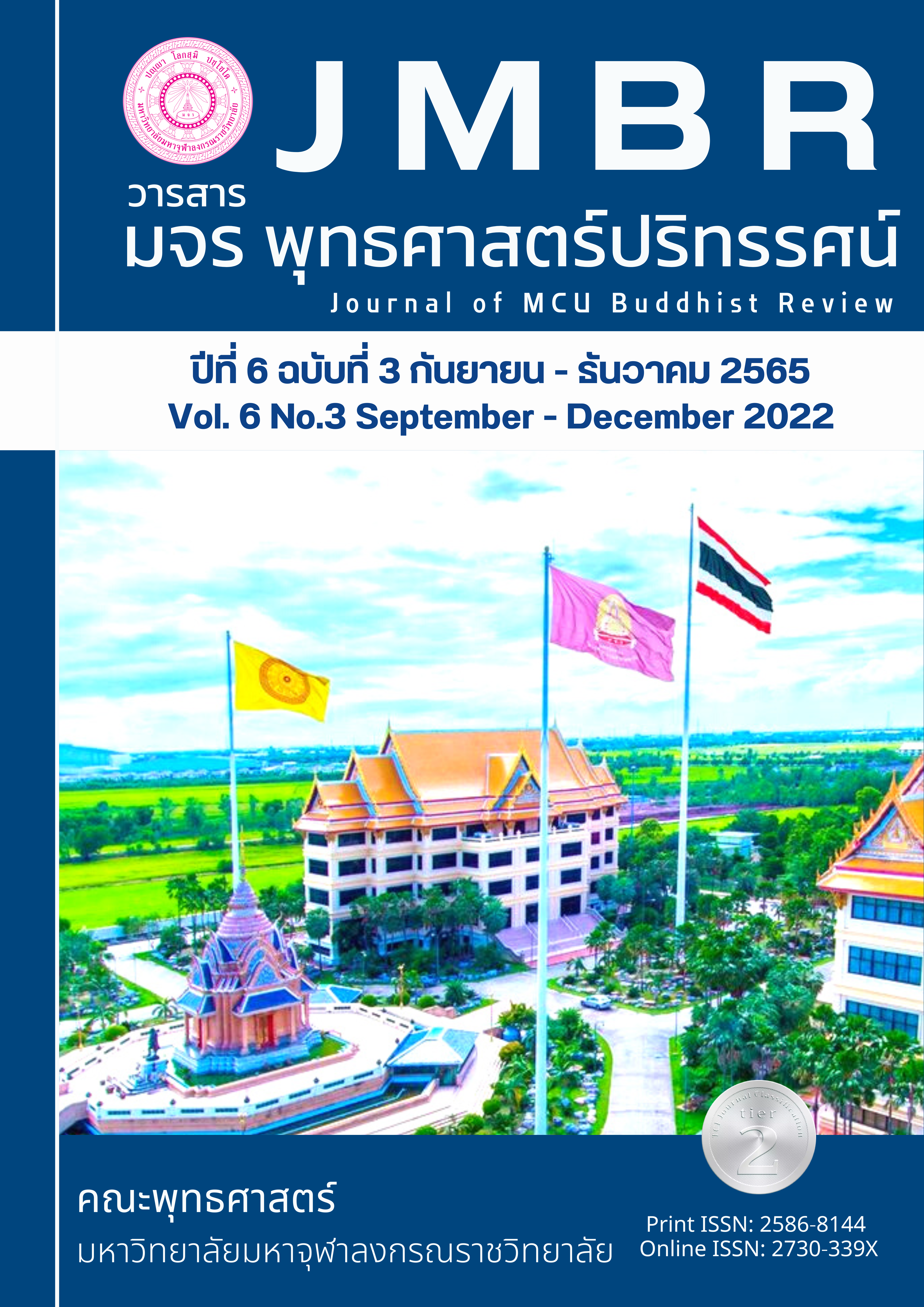แนวทางการปฏิบัติกรรมฐานของพระมหาเถรศรีศรัทธา
Main Article Content
บทคัดย่อ
บทความวิชาการนี้ ผู้เขียนต้องการนำเสนอแนวทางการปฏิบัติกรรมฐานของพระมหาเถรศรีศรัทธาในสมัยสุโขทัย การศึกษาพบว่า แนวการปฏิบัติกรรมฐานของพระมหาเถรศรีศรัทธานั้นมีความสอดคล้องกับกรรมฐานในคัมภีร์พระพุทธศาสนา เช่น พระไตรปิฎก คัมภีร์
วิสุทธิมรรค เป็นต้น และปรากฏแนวกรรมฐานที่เด่นชัดตามจริยาวัตรของท่านคือ เมตตากรรมฐาน สมถกรรมฐานและวิปัสสนากรรมฐาน ซึ่งมีเป้าหมายการปฏิบัติและบำเพ็ญบารมีเพื่อตรัสรู้เป็นพระพุทธเจ้าพระองค์หนึ่งในอนาคต
ลักษณะของพระมหาเถรศรีศรัทธาเป็นทั้งพระคามวาสีและอรัญญวาสีที่มุ่งสงเคราะห์ประชาชน ท่านบูรณะปฏิสังขรณ์ศาสนวัตถุและปฏิบัติธรรมควบคู่กัน ขณะเดียวกันได้เที่ยวสั่งสมบารมีเพื่อเป็นปัจจัยแห่งการตรัสรู้เป็นพระพุทธเจ้าในอนาคต อาจเรียกการบำเพ็ญกรรมฐานในสายนี้ว่า “กรรมฐานสายพระโพธิสัตว์” เพราะสายนี้มุ่งบำเพ็ญบารมี ฌาน และวิปัสสนา ไปพร้อมกันนั่นเอง
Article Details

อนุญาตภายใต้เงื่อนไข Creative Commons Attribution-NonCommercial-NoDerivatives 4.0 International License.
- บทความที่ได้รับการตีพิมพ์เป็นลิขสิทธิ์ของวารสาร มจร พุทธศาสตร์ปริทรรศน์
- ข้อความใดๆ ที่ปรากฎในบทความที่ได้รับการตีพิมพ์ในวารสาร ถือเป็นความรับผิดชอบของผู้เขียนบทความ และข้อคิดเห็นนั้นไม่ถือว่าเป็นทัศนะและความรับผิดชอบของกองบรรณาธิการวารสาร มจร พุทธศาสตร์ปริทรรศน์
เอกสารอ้างอิง
มหาจุฬาลงกรณราชวิทยาลัย. (2539). พระไตรปิฎกภาษาไทย ฉบับมหาจุฬาลงกรณราชวิทยาลัย. กรุงเทพมหานคร: โรงพิมพ์มหาจุฬาลงกรณราชวิทยาลัย.
มหาจุฬาลงกรณราชวิทยาลัย. (2532). อรรถกถาภาษาบาลี ฉบับมหาจุฬาอฏฺกถา. กรุงเทพมหานคร: โรงพิมพ์มหาจุฬาลงกรณราชวิทยาลัย.
มหาจุฬาลงกรณราชวิทยาลัย. (2534). สมนฺตปาสาทิกา (ปฐโม ภาโค). กรุงเทพมหานคร: โรงพิมพ์มหาจุฬาลงกรณราชวิทยาลัย.
มหาจุฬาลงกรณราชวิทยาลัย. (2532). อฏฺฐสาลินี (ปฐโม ภาโค). กรุงเทพมหานคร: โรงพิมพ์วิญญาณ.
พระพุทธโฆษาจารย์. (2539). วิสุทฺธิมคฺคปกรณํ (ปฐโม ภาโค). กรุงเทพมหานคร: สำนักค้นคว้าทางวิญญาณ.
พระพุทธทัตตเถระ. (2549). อภิธัมมาวตาร. พระคันธสาราภิวงศ์ แปลและอธิบาย. กรุงเทพมหานคร: ห้างหุ้นส่วนจำกัด.
มหามกุฏราชวิทยาลัย. (2538). อภิธมฺมตฺถสงฺคหปาลิยา สห อภิธมฺมตฺถวิภาวินีนาม อภิธมฺมตฺถสงฺคหฏีกา. กรุงเทพมหานคร: โรงพิมพ์มหามกุฏราชวิทยาลัย.
กรมศิลปากร. (2527). จารึกสมัยสุโขทัย. กรุงเทพมหานคร: กรมศิลปากร (กรมศิลปากร จัดพิมพ์เนื่องในโอกาสฉลอง 700 ปี ลายสือไทย พุทธศักราช 2526).
กรมศิลปากร. (2539). เรือพระราชพิธี. กรุงเทพมหานคร: บริษัทรุ่งศิลป์การพิมพ์.
ปรีดี พิศภูมิวิถี. (2561). สยามศึกษาในสายตาฝรั่ง. กรุงเทพมหานคร: โรงพิมพ์แห่งจุฬาลงกรณ์มหาวิทยาลัย.
พระพรหมคุณาภรณ์ (ป.อ. ปยุตฺโต). (2554). พจนานุกรมพุทธศาสน์ ฉบับประมวลศัพท์. กรุงเทพมหานคร: โรงพิมพ์พระพุทธศาสนาของธรรมสภา.
ภัทรพร สิริกาญจน. (2557). พระพุทธศาสนาในประเทศไทย: เอกภาพบนความหลากหลาย. กรุงเทพมหานคร: สำนักพิมพ์มหาวิทยาลัยธรรมศาสตร์.
ลาลูแบร์. ซิมอน เดอ. (๒๕๔๘). จดหมายเหตุลาลูแบร์ ราชอาณาจักรสยาม. นนทบุรี: ศรีปัญญา.
ราชบัณฑิตยสถาน. (2556). พจนานุกรมราชบัณฑิตสถาน พ.ศ.๒๕๕๔ เฉลิมพระเกียรติพระบาทสมเด็จพระเจ้าอยู่หัว เนื่องในโอกาสพระราชพิธีมหามงคลเฉลิมพระชนมพรรษา ๗ รอบ ๕ ธันวาคม ๒๕๕๔. กรุงเทพมหานคร: ราชบัณฑิตสถาน.
ระวี ภาวิไล. (2548). อภิธรรมสำหรับคนรุ่นใหม่. กรุงเทพมหานคร: บริษัทพิมพ์สวยจำกัด.
Kong Meng San Phor Kark See Monastery. (2016). Buddhism for Beginners. Singapore.
Nyanatiloka. (2007). Budddhist Dictionary: a manual of Buddhist Terms and Doctrines. Bangkok: O.S.Printing House.
Walpola Sri Rahula. (2009). What the Buddha taught. How Tri Foundation, Thailand.


